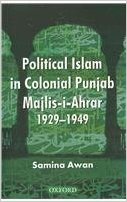The study of an ideologized and activist organiation like the Majlis-i-Ahrar-i-Islam(MAI) is actually a journey through several inter-related domains including political Islam, South Asian Muslim identity politics, and the metamorphosis of Punjab from a bastion of the Raj to a sword arm for the Pakistan Movement. Here, the agitational pattern was moulded by the complex mix of region, culture, class, creed, oratory, and populist politics. Moreover, a close survey of the activities of MAI, enables us to understand the rural-urban dichotomy. The Ahrar leaders brought a synthesis between the divergent forces of modernity and tradition by manipulating the print culture, trans-regional Islam and composite Indian nationalism. Yet this leadership was overtaken by even larger movements (INC and AIML), which offered more comprehensive and competitive programmes. The investigation of an organization like the MAI reveals the centrality of politics of personalities and issues within a broad political and ideological context.
It drew its sustenance from the middle class, urban Muslim professionals, who espoused complete independence for India and were in favour of the empowerment of the deprived and marginalized groups both in the princely states and British India. MAI rallied people by relying on traditional modes such as oratory, mosque-based activism and voluntary support secured in the name of Islam and higher moral values. It strove to make its presence felt on several fronts and that too during the most challenging decades preceding Independence and at times, filled up prisons with its activists. Approaching the history of Punjab by investigating quasi-peripheral organizations and movements such as the MAI and the Khaksars has added a new dimension in South Asian historical research as manifested in two books published in 2010, one the book under review, and the other one entitled The Khaksar Movement (2 vols) by Amalendu De.

